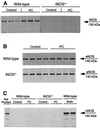The late phase of ischemic preconditioning is abrogated by targeted disruption of the inducible NO synthase gene
- PMID: 10500207
- PMCID: PMC18064
- DOI: 10.1073/pnas.96.20.11507
The late phase of ischemic preconditioning is abrogated by targeted disruption of the inducible NO synthase gene
Abstract
The goal of this study was to interrogate the role of inducible NO synthase (iNOS) in the late phase of ischemic preconditioning (PC) in vivo. A total of 321 mice were used. Wild-type mice preconditioned 24 h earlier with six cycles of 4-min coronary occlusion/4-min reperfusion exhibited a significant (P < 0.05) increase in myocardial iNOS protein content, iNOS activity (assessed as calcium-independent L-citrulline formation), and nitrite + nitrate tissue levels. In contrast, endothelial NOS protein content and calcium-dependent NOS activity remained unchanged. No immunoreactive neuronal NOS was detected. When wild-type mice were preconditioned 24 h earlier with six 4-min occlusion/4-min reperfusion cycles, the size of the infarcts produced by a 30-min coronary occlusion followed by 24 h of reperfusion was reduced markedly (by 67%; P < 0.05) compared with sham-preconditioned controls, indicating a late PC effect. In contrast, when mice homozygous for a null iNOS allele were preconditioned 24 h earlier with the same protocol, infarct size was not reduced. Disruption of the iNOS gene had no effect on early PC or on infarct size in the absence of PC. These results demonstrate that (i) the late phase of ischemic PC is associated with selective up-regulation of iNOS, and (ii) targeted disruption of the iNOS gene completely abrogates the infarct-sparing effect of late PC (but not of early PC), providing unequivocal molecular genetic evidence for an obligatory role of iNOS in the cardioprotection afforded by the late phase of ischemic PC. Thus, this study identifies a specific protein that mediates late PC in vivo.
Figures




Comment in
-
NO news is good news.Proc Natl Acad Sci U S A. 1999 Sep 28;96(20):10953-4. doi: 10.1073/pnas.96.20.10953. Proc Natl Acad Sci U S A. 1999. PMID: 10500105 Free PMC article. No abstract available.
References
-
- Cohen M V, Downey J M. Cardiol Rev. 1995;3:137–149.
-
- Marber M S, Yellon D M. Ann NY Acad Sci. 1996;793:123–141. - PubMed
-
- Kuzuya T, Hoshida S, Yamashita N, Fuji H, Oe H, Hori M, Kamada T, Tada M. Circ Res. 1993;72:1293–1299. - PubMed
-
- Marber M S, Latchman D S, Walker J M, Yellon D M. Circulation. 1993;88:1264–1272. - PubMed
-
- Yang X M, Baxter G F, Heads R J, Yellon D M, Downey J M, Cohen M V. Cardiovasc Res. 1996;31:777–783. - PubMed
Publication types
MeSH terms
Substances
Grants and funding
LinkOut - more resources
Full Text Sources
Other Literature Sources
Molecular Biology Databases

